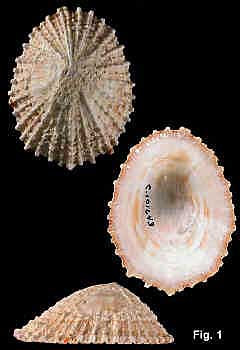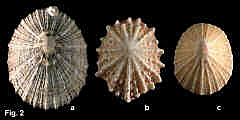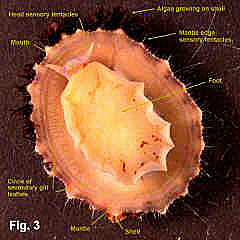|
|
|
||||||||
|
|
Scutellastra peronii (Blainville, 1825) Description: Shell variable in form. Typical NSW shell solid, with apex varying from nearly central to anterior third. Sculptured with about 25 strong, scaly radial ribs, with finer secondary ribs between; margin crenulate. Exterior colour uniformly cream or fawn, but usually not evident because of erosion. Interior colour variable; sometimes uniformly white, but more frequently with yellow or brown margin, mid region white or grey, and spatula irregularly coloured with tan, grey or black. Size: Up to 52 mm in length, commonly about 35 mm. Distribution: Endemic to Australia: Coolangatta, Queensland, to Shark Bay, WA, including Tasmania. Habitat: This species is common on exposed rocky shores, in the lower littoral and shallow sublittoral, in a zone where algal growth is abundant. Underwood (1974) studied spawning of this species at Cape Banks in Botany Bay and found two spawnings in one year, in June-July and February-April. Parry (1982) found that at San Remo in Victoria, the species also spawned twice in one year, but in early November and early March. Parry found that sexual maturity was reached at an age of one year, when shell length was 25 mm. At this age the shell growth rate was 0.8 mm per year, slowing to 0.3 mm per year at five years of age. The size at five years was 45 mm. Mortality of animals at one year or older was 50% per year; hence very few survived after five years. This species feeds on small macroalgae in a zone where algae is abundant all the year, so it probably never suffers from food shortages. Parry found it was predated on by two species of wrasse, which accounted for almost all of the mortality, keeping the population level low enough that competition for food did not occur. The fish preferentially ate smaller limpets, on average about 10 mm in size. There was occasional predation by oystercatchers, but only at very low tide when the birds could reach the limpets. Predation by boring gastropods (Agnewia tritoniformis, Dicathais orbita) was rare. Comparison: Recognised by the strong scaly ribs with secondary riblets between. Patelloida alticostata is similar in size, but has smooth ribs and a typical black cobweb colour pattern. Synonymy: Throughout its range from southern Queensland to southern WA this species varies considerably in colour and sculpture. The form commonly found in NSW, as described above, is sculptured with strong, scaly ribs and was named Patella squamifera Reeve, 1855. The peronii form, with more radials, dark with an occasional pale one, is more common in SA and Victoria. Another form with uniform black radials was named Patella hepatica Verco, 1906. Another synonym is Patella ustulata Reeve, 1855 Fig. 1 Warden Head, Ulladulla, NSW (C.101643) Fig. 2 a. Collaroy, NSW (C.087597) b. Maroubra, NSW (C.349472) c. Gerringong, NSW (C.066004) Fig. 3 Live animal. Long Reef, Collaroy, NSW (DLB5072)
|


